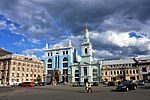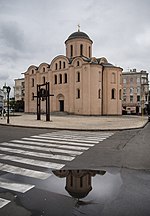Fountain of Samson, Kyiv
Buildings and structures in KyivFountains in UkraineMonuments and memorials in KyivPodilskyi District

The Fountain of Samson or Felitsiyal (Ukrainian: Фонтан Самсон, Феліціял, translit.: Fontan Samson, Felitsiial) is a Ukrainian Baroque fountain in the Podil raion of Kyiv. It was constructed in the 18th century, later demolished in 1934 or 1935, and rebuilt in 1981.
Excerpt from the Wikipedia article Fountain of Samson, Kyiv (License: CC BY-SA 3.0, Authors, Images).Fountain of Samson, Kyiv
Kontraktova Square, Kyiv Podil
Geographical coordinates (GPS) Address External links Nearby Places Show on map
Geographical coordinates (GPS)
| Latitude | Longitude |
|---|---|
| N 50.464166666667 ° | E 30.516944444444 ° |
Address
Самсон
Kontraktova Square
04070 Kyiv, Podil
Ukraine
Open on Google Maps










